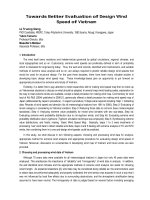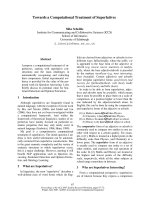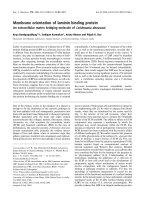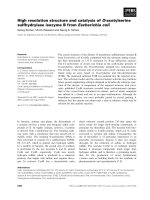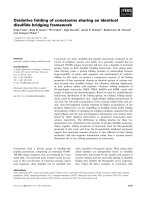Báo cáo khoa học: "Towards resolution of bridging descriptions" docx
Bạn đang xem bản rút gọn của tài liệu. Xem và tải ngay bản đầy đủ của tài liệu tại đây (258.98 KB, 3 trang )
Towards resolution of bridging descriptions
Renata
Vieira and Simone Teufel
Centre for Cognitive Science - University of Edinburgh
2, Buccleuch Place EH8 9LW Edinburgh UK
{renat a, simone}©cogsci, ed. ac. uk
Abstract
We present preliminary results concern-
ing robust techniques for resolving bridging
definite descriptions. We report our anal-
ysis of a collection of 20 Wall Street Jour-
nal articles from the Penn Treebank Cor-
pus and our experiments with WordNet to
identify relations between bridging descrip-
tions and their antecedents.
1 Background
As part of our research on definite description (DD)
interpretation, we asked 3 subjects to classify the
uses of DDs in a corpus using a taxonomy related
to the proposals of (Hawkins, 1978) (Prince, 1981)
and (Prince, 1992). Of the 1040 DDs in our corpus,
312 (30%) were identified as anaphoric (same head),
492 (47%) as larger situation/unfamiliar (Prince's
discourse new), and 204 (20%) as bridging refer-
ences, defined as uses of DDs whose antecedents
coreferential or not have a different head noun; the
remaining were classified as idioms or were cases for
which the subjects expressed doubt see (Poesio and
Vieira, 1997) for a description of the experiments.
In previous work we implemented a system ca-
pable of interpreting DDs in a parsed corpus
(Vieira and Poesio, 1997). Our implementation
employed fairly simple techniques; we concentrated
on anaphoric (same head) descriptions (resolved by
matching the head nouns of DDs with those of
their antecedents) and larger situation/unfamiliar
descriptions (identified by certain syntactic struc-
tures, as suggested in (Hawkins, 1978)). In this
paper we describe our subsequent work on bridging
DDs, which involve more complex forms of common-
sense reasoning.
2 Bridging descriptions: a corpus
study
Linguistic and computational theories of bridg-
ing references acknowledge two main problems in
their resolution: first, to find their antecedents
(ANCHORS)
and second, to find the relations
(LINKS)
holding between the descriptions and their anchors
(Clark, 1977; Sidner, 1979; Heim, 1982; Carter,
1987; Fraurud, 1990; Chinchor and Sundheim, 1995;
Strand, 1997). A speaker is licensed in using a bridg-
ing DD when he/she can assume that the common-
sense knowledge required to identify the relation is
shared by the listener (Hawkins, 1978; Clark and
Marshall, 1981; Prince, 1981). This reliance on
shared knowledge means that, in general, a system
could only resolve bridging references when supplied
with an adequate lexicon; the best results have been
obtained by restricting the domain and feeding the
system with specific knowledge (Carter, 1987). We
used the publicly available lexical database Word-
Net (WN) (Miller, 1993) as an approximation of a
knowledge basis containing generic information.
Bridging DDs and WordNet As a first experi-
ment, we used WN to automatically find the anchor
of a bridging DD, among the NPs contained in the
previous five sentences. The system reports a se-
mantic link between the DD and the NP if one of
the following is true:
• The NP and the DD are synonyms of each other,
as in
the suit the lawsuit.
• The NP and the DD are in direct hyponymy
relation with each other, for instance,
dollar the
currency.
• There is a direct or indirect meronymy (part-
of relation) between the NP and the DD. Indirect
meronymy holds when a concept inherits parts from
its hypernyms, like
car
inherits the part
wheel
from
its hypernym
wheeled_vehicle.
• Due to WN's idiosyncratic encoding, it is often
522
necessary to look for a semantic relation between
sisters, i.e. hyponyms of the same hypernym, such
as home the house.
An automatic search for a semantic relation
in
5481 possible anchor/DD pairs (relative to 204
bridging DDs) found a total of 240 relations, dis-
tributed over 107 cases of DDs. There were 54 cor-
rect resolutions (distributed over 34 DDs) and 186
false positives.
Types of
bridging definite descriptions A
closer analysis revealed one reason for the poor
results: anchors and descriptions are often linked
by other means than direct lexico-semantic rela-
tions. According to different anchor/link types and
their processing requirements, we observed six ma-
jor classes of bridging DDs in our corpus:
Synonymy/Hyponymy/Meronymy These DDs
are in a semantic relation with their anchors that
might be encoded in WN. Examples are: a) Syn-
onymy: new album the record, three bills
the legislation; b) Hypernymy-Hyponymy: rice
the plant, the television show the program; c)
Meronymy: plants the pollen, the house the
chimney.
Names Definite descriptions may be anchored to
proper names, as in: Mrs. Park the housewife
and Pinkerton's Inc the company.
Events There are cases where the anchor of a bridg-
ing DD is not an NP but a VP or a sentence. Ex-
amples are: individual investors contend. They
make the argument in letters ; Kadane Oil Co. is
currently drilling two wells The activity
Compound Nouns This class of DDs requires con-
sidering not only the head nouns of a DD and its
anchor for its resolution but also the premodifiers.
Examples include: stock market crash the mar-
kets, and discount packages the discounts.
Discourse Topic There are some cases of DDs
which are anchored to an implicit discourse topic
rather than to some specific NP or VP. For instance,
the industry (the topic being oil companies) and the
first half (the topic being a concert).
Inference One other class of bridging DDs includes
cases based on a relation of reason, cause, conse-
quence, or set-members between an anchor (previous
NP) and the DD (as in Republicans/Democratics
the two sides, and last week's earthquake the suf-
fering people are going through).
The relative importance of these classes in our
corpus is shown in Table 1. These results explain
in part the poor results obtained in our first experi-
ment: only 19% of the cases of bridging DDs fall into
the category which we might expect WN to handle.
Class
# % Class # %
S/H/M 38 19% C.Nouns 25 12%
Names 49 24% D.Topic 15 07%
Events 40 20% Inference 37 18%
Table 1: Distribution of types of bridging DDs
3 Other experiments with WordNet
Cases that WN could handle Next, we consid-
ered only the 38 cases of syn/hyp/mer relations and
tested whether WN encoded a semantic relation be-
tween them and their (manually identified) anchors.
The results for these 38 DDs are summarized in Ta-
ble 2. Overall recall was 39% (15/38). 1
Class Total Found in WN Not Found
Syn 12 4 8
Hyp 14 8 6
Mer 12 3 9
Table 2: Search for semantic relations in WN
Problems with WordNet Some of the missing
relations are due to the unexpected way in which
knowledge is organized in WN. For example, our
artifact
I
structure/1
construction/4
. part of
housing building ~
lodging edifice
" all
/\
house dwelling, home
/~
part_of
specific houses
blood family
Figure 1: Part of WN's semantic net for buildings
method could not find an association between house
and walls, because house was not entered as a hy-
ponym of building but of housing, and housing does
1 Our previous experiment found correct relations for
34 DDs, from which only 18 were in the syn/hyp/mer
class. Among these 18, 8 were based on different anchors
from the ones we identified manually (for instance, we
identified pound the currency, whereas our automatic
search found sterling the currency). Other 16 correct
relations resulting from the automatic search were found
for DDs which we have ascribed manually to other classes
than syn/hyp/mer, for instance, a relation was found for
the pair Bach the composer, in which the anchor is
a name. Also, whereas we identified the pair Koreans
the population, the search found a WN relation for
nation the
population.
523
not have a meronymy link to
wall
whereas
building
does. On the other hand, specific houses
(school-
house, smoke house, tavern)
were encoded in WN
as hyponyms of
building
rather than hyponyms of
house
(Fig. 1).
Discourse structure Another problem found in
our first test with WN was the large number of false
positives. Ideally, we should have a mechanism for
focus tracking to reduce the number of false posi-
tives- (Sidner. 1979), (Grosz, 1977). We repeated
our first experiment using a simpler heuristic: con-
sidering only the closest anchor found in a five sen-
tence window (instead of all possible anchors). By
adopting this heuristic we found the correct anchors
for 30 DDs (instead of 34) and reduced the number
of false positives from 186 to 77.
4 Future work
We are currently working on a revised version of the
system that takes the problems just discussed into
account. A few names are available in WN, such as
famous people, countries, cities and languages. For
other names, if we can infer their entity type we
could resolve them using WN. Entity types can be
identified by complements like
Mr., Co., Inc.
etc.
An initial implementation of this idea resulted in
the resolution of .53% (26/49) of the cases based
on names. Some relations are not found in WN,
for instance,
Mr. Morishita
(type person)
the 57
year-old.
To process DDs based on events we could
try first to transform verbs into their nominalisa-
tions, and then looking for a relation between nouns
in a semantic net. Some rule based heuristics or a
stochastic method are required to 'guess' the form
of a nominalisation. We propose to use WN's mor-
phology component as a stemmer, and to augment
the verbal stems with the most common suffixes for
nominalisations, like
-ment, -ion.
In our corpus, 16%
(7/43) of the cases based on events are direct nom-
inalisations (for instance,
changes were proposed
the proposals),
and another 16% were based on se-
mantic relations holding between nouns and verbs
(such as
borrou~,ed the loan).
The other 29 cases
(68%) of DDs based on events require inference rea-
soning based on the compositional meaning of the
phrases (as in
It u~ent looking for a partner the
prospect);
these cases are out of reach just now, as
well as the cases listed under "'discourse topic" and
"inference". We still have to look in more detail at
compound nouns.
References
Carter, D. M. 1987.
Interpreting Anaphors in .Vat-
ural Language Tezts.
Ellis Horwood, Chichester.
UK.
Chinchor, N. A. and B. Sundheim. 1995. (MUC)
tests of discourse processing. In
Proc.
AAA[
SS
on Empirical Methods in Discourse Interpretation
and Generation.
pages 21-26, Stanford.
Clark, H. H. 1977. Bridging. In Johnson-Laird
and Wason, eds
Thinking: Readings in Cognitive
Science.
Cambridge University Press, Cambridge.
Clark, H. H. and C. P~. Marshall. 1981. Definite ref-
erence and mutual knowledge. In Joshi, Webber
and Sag,
eds.,Elements of Discourse Understand-
ing.
Cambridge University Press, Cambridge.
Fraurud, K. 1990. Definiteness and the Processing
of Noun Phrases in Natural Discourse.
Journal of
Semantics,
7, pages 39.5-433.
Grosz, B. J. 1977.
The Representation and Use of
Focus in Dialogue Understanding.
Ph.D. thesis,
Stanford University.
Hawkins, J. A. 1978.
Definiteness and Indefinite-
ness.
Croom Helm, London.
Helm, I. 1982.
The Semantics of Definite and In-
definite Noun Phrases.
Ph.D. thesis, University of
Massachusetts at Amherst.
Miller, G. et al. 1993. Five papers in WordNet.
Technical Report CSL Report ~3,
Cognitive Sci-
ence Laboratory, Princeton University.
Poesio, M. and Vieira. R. 1997. A Corpus
based investigation of definite description use.
Manuscript, Centre for Cognitive Science, Univer-
sity of Edinburgh.
Prince, E. 1981. Toward a taxonomy of given/new
information. In Cole. ed.,
Radical Pragmatics.
Academic Press. New York, pages '223-255.
Prince, E. 1992. The ZPG letter: subjects, definete-
ness, and information-status. In Thompson and
Mann, eds.,
Discourse description: diverse analy-
ses of a fund raising text.
Benjamins. Amsterdam,
pages 295-325.
Sidner, C. L. 1979.
Towards a computational the-
ory of definite anaphora comprehension in English
discourse.
Ph.D. thesis. MIT.
Strand, K. 1997. A Taxonomy of Linking Relations.
Journal of Semantics,
forthcoming.
Vieira, R. and M. Poesio. 1997. Corpus-based
processing of definite descriptions. In Botley and
McEnery eds.,
Corpus-based and computational
approaches to anaphora.
UCL Press. London.
524
